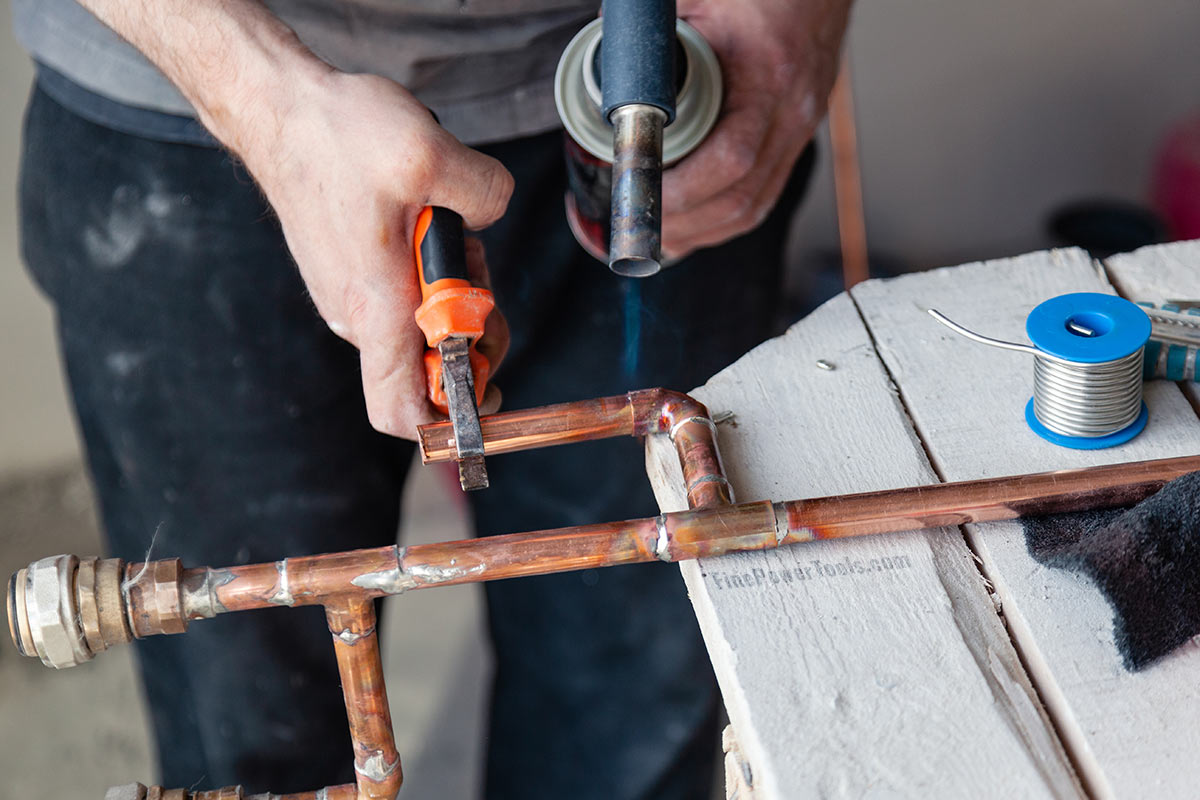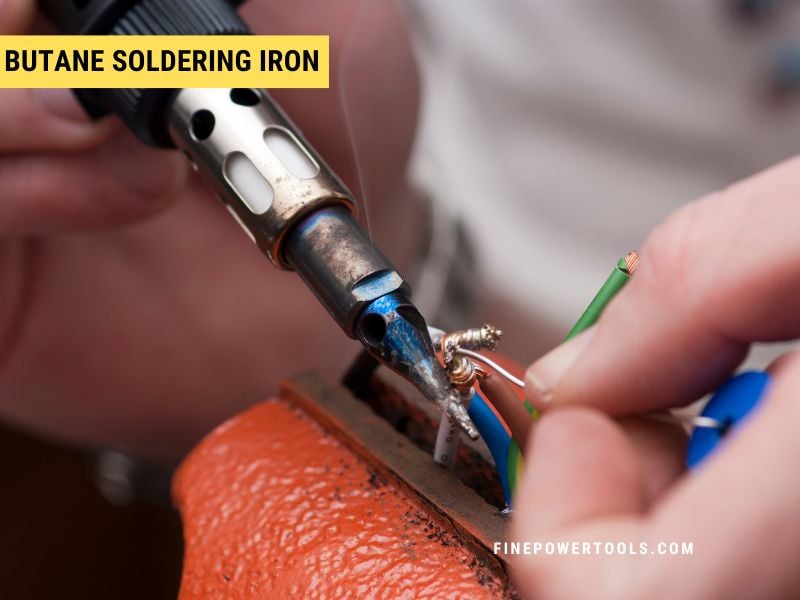Butane soldering irons come with a nozzle that enables them to be used as torches, adding extra functionality and practicality. Remove the tip, and you have a compact gas torch in hand.
But is this dual-use feature just a gimmick, or can it perform tasks usually reserved for a conventional butane blow torch?

In this article, I will compare the features, benefits, and drawbacks of butane soldering iron torches and conventional butane torches to give you insight into their effectiveness.
Looking for Butane vs. Electric Soldering Iron comparison?
Butane Soldering Iron
An appealing thing about butane soldering irons is their quick conversion capability to butane torches, allowing you to melt harder solder and work in plumbing, roofing, and other applications requiring more heat and volume than an electric soldering iron can generate.
These soldering irons have a small tank loaded with butane and promise excellent results.
Key Features
Let’s take a look at the average butane soldering iron torch’s main features and specifications:
- Maximum Temperature: Depending on the model, butane soldering irons’ torches can make up to about 1300 °C to 1500 °C (2372 °F to 2732°F).
- Flame Size Regulation: The flame’s temperature is fixed, but you can adjust the flame size by adjusting the gas flow. Adjusting the flame size can affect the temperature, but you cannot control the temperature precisely.
- Flame Type: Because of their construction and working principle (similar to catalytic lighters), the flame is expelled from the nozzle at high speed and forms a conical shape. This concentrates the heat in a relatively small area.
- Automatic Ignition: Most models feature a piezoelectric igniter that generates an electric spark and sets the flame on. This way, you don’t have to use a lighter or an external source to make it work.
- Size: These tools are pretty small; even the more robust models fit comfortably in the palm of your hand. This makes them ideal for working in hard-to-reach areas or small surfaces.
- Runtime: When used as a torch, butane soldering irons have an average operating time of 30 minutes.
- Butane Capacity: Butane soldering irons have an average gas capacity of 20 or 30 ml.
Pros and Cons of Butane Soldering Irons
Pros
- Versatility: They can work as a soldering iron or as a torch.
- Precision: Their concentrated heat makes it practical for delicate tasks like desoldering electronic components, jewelry, or other jobs requiring precise heat application.
- Light and Compact: They are smaller than standard butane torches, making them great for maneuvering in tight spaces or hard-to-reach areas.
Cons
- Small Heat Coverage: The same feature that makes them a pro is also a con for applications that require heating large areas.
- Short Runtime: Due to their small fuel tank, these tools offer limited operating time, making them impractical for extended use.
- Price: Their price ranges from about double that of a conventional butane torch.
Conventional Butane Torches or Blow Torches
There are two types of butane blow torches: the simplest ones are nozzles that attach to a butane can, while the most advanced models have their own tank with the nozzle attached to it.
Both types have very similar features; their main difference is their autonomy (runtime), which varies depending on their gas tank and their size. However, they can be considered as the same tool.
Key Features
Following are the features and specs of a conventional butane torch.
- Maximum Temperature: Depending on the model, the maximum temperature you can achieve with one of these torches goes from 1300 °C to 1600 °C (2372 °F to 2912 °F).
- Flame Size Regulation: As with butane soldering iron torches, you can adjust the flame size or intensity by adjusting the gas flow. However, adjusting the flame size doesn’t help much to control its temperature accurately.
- Flame Type: The flame type depends on the tool’s nozzle; however, it tends to be more dispersed than the one produced by butane soldering irons’ torches. It covers a broader area, which is good for heating large surfaces but sacrificing precision.
- Automatic Ignition: Most models have manual ignition; you must open the gas valve first and then ignite the butane using a lighter or other heat source. However, some models feature piezoelectric igniters that are activated by pressing a button, and more advanced models automatically start working as soon as you open the gas valve.
- Size: These tools are pretty bulky; they have a standard-size butane can underneath the nozzle or even a much larger tank. This makes them pretty uncomfortable to work in tight spaces.
- Runtime: A 250cc butane can last about 2.5 hours at maximum capacity. Models with larger tanks can be operated for longer duration, depending on their size.
- Butane Capacity: Butane gas cans come in sizes of 5oz to 8oz and 150cc to 250cc. Butane torches with incorporated tanks have an average capacity of about 400 cc.
Pros and Cons
Pros
- Wide Flame Spread: Their broad flame is ideal for conducting heavy-duty tasks like quickly joining two pipes.
- High Autonomy: Thanks to their big tank, these tools can work for hours with a single charge.
- Affordable: Including the butane can, they are cheap, with models that cost less than $20, including the gas.
Cons
- Large Flame Size: The same feature that makes them a pro is also a con for applications that require precision and focused heat.
- Size: They are larger than the pen-type butane gas soldering irons.
- Manual Ignition: Most models must be ignited manually using an external device like a lighter.
Which Butane Tool is Best for You?
Considering that both tools generate almost the same temperature, enough for melting solder used for soldering and brazing the same applications, the difference lies in the jobs you do most frequently.
For example, when I work at my tuning shop, sometimes I need to connect aluminum or copper pipes.
The solder I use that works for brazing aluminum is pretty hard and takes some time to melt with propane. In that case, a conventional butane torch works best for me because to create a proper bond, I need to melt the solder bar and keep the pipes heated.
Besides, the long runtime of the conventional torch allows me to do jobs like joining aluminum pipes without worrying about how much fuel I have left.
On the other hand, a butane soldering iron can be convenient for applications like joining two 1 ½” copper pipes together, where solder isn’t as hard as the one used for aluminum.
But, your choice between the two might ultimately depend on the frequency and type of tasks you handle, such as how many copper pipes you join in a day.
For eventual home repair jobs and precision jobs, a butane soldering iron is a great tool; however, I would choose a traditional butane torch for daily work, repetitive tasks, or heavy-duty applications because of its autonomy and thermal efficiency.
Safety Precautions
Both torches must be used responsibly and carefully since both use butane gas as fuel and produce heat in the form of a flame.
Always follow the manufacturer’s instructions while using them, and remember to:
- Use them in well-ventilated areas to reduce the risk of fire or explosions.
- Wear safety glasses and heat-resistant gloves.
- Try to avoid holding the workpieces with your hands; use a vice or other means to keep them in place.
- Work in a free area and keep flammable materials away from it.
- Have a fire extinguisher handy whenever you are working with a torch.
- Keep the butane soldering iron away from heat sources while refilling it.
- Never leave the tool unattended while the flame is on and turn it off immediately when not using it.
- Keep the tools away from children and pets.
- Store the butane cans away from direct sunlight and heat.
- Properly dispose of the butane cans; avoid puncturing or incinerating them.
I strongly recommend reading our essential soldering safety guide before you begin working with these tools.
Wrapping It Up
In summary, both butane soldering irons and butane torches offer unique advantages and limitations.
- Soldering irons excel in precision tasks and hard-to-reach areas but may lack the runtime for extended projects.
- On the other hand, butane torches provide broader heat coverage and longer runtime, making them ideal for heavy-duty tasks.
Your choice should ultimately depend on the specific requirements of your work—whether it demands precision, duration, or a bit of both.





